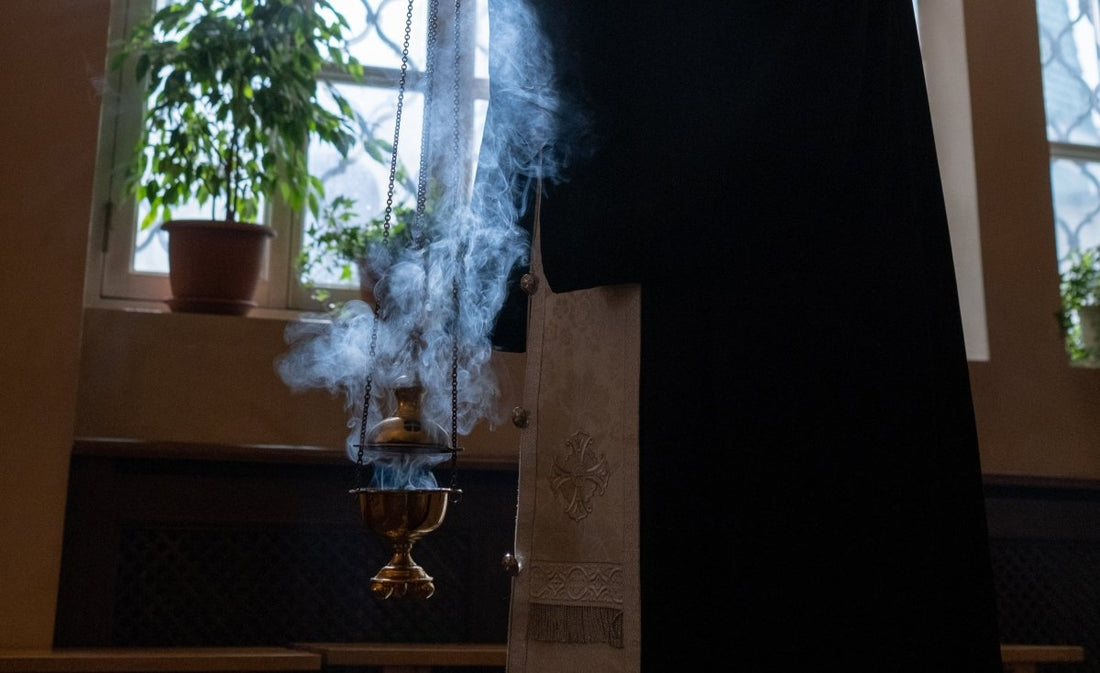Ever walked into a Catholic church and found yourself enveloped by an aromatic cloud that felt almost sacred?
That's the power of church incense.
But what exactly is the smell of church incense?
It's more than just a pleasant aroma; it's a scent steeped in centuries-old traditions, telling a tale of devotion and spirituality.
This blog post aims to take you on an olfactory journey. We’ll explore the intricate details behind that distinctive aroma, its significance, and how it enhances the spiritual experience.
We'll uncover the ingredients that lend it its unique scent and delve into the process of burning incense. Intriguing, isn't it?
So, what do you say? Ready to decode the heavenly aroma that fills our churches? Let's begin!
Incense in Catholic Churches: A Fragrant Symbolism
In the Roman Catholic Church, the tradition of burning incense is a rich tapestry woven through the centuries. The aromatic smoke not only purifies the altar but also signifies the prayers of the faithful ascending heavenwards. Imagine each grain of incense transformed into a whispering prayer, reaching up to the divine!
The aromatic smoke wafting towards the heavens is symbolic and signifies the 'prayers of the saints', as mentioned in the Book of Revelation, rising to God.

Journey Through Church Incense: Varieties and their Aromas
Let's embark on an olfactory exploration of church incense. There are different types of incense, but two stand out in the Catholic Church – frankincense and myrrh. Frankincense, a gum resin, fills the air with a sweet, citrusy, and slightly piney aroma.
Myrrh, on the other hand, offers a more complex scent - rich, smoky, and slightly bitter. Other types like benzoin and copal add to this divine blend, creating an aroma that's unique and instantly recognisable.
The Sacred Ritual: Incense Burning in Churches
Burning incense is an art, steeped in ritual and reverence. Incense grains go in a censer or 'thurible'. And as the incense burns, it releases an aromatic smoke that dances through the church, enveloping it all in its sweet smells.
As part of the ritual, the member of the clergy would then 'incense the altar', symbolising the prayers of the faithful rising to heaven and sanctifying the ceremony. The whole process, from lighting the charcoal to the final billowing cloud, is a mesmerising spectacle of faith.

The Scented Impact: Incense Aroma and Worship Experience
Ever wondered about the psychological and spiritual impact of incense aroma on the worship experience? The sweet scent of burning incense helps create an atmosphere of tranquillity, serenity, and sacredness.
It enhances the worship experience, promoting a sense of connection with the divine. But don't just take our word for it - research and anecdotal evidence both underline these profound effects!
According to the Catholic Encyclopaedia, the use of incense bears a symbolic meaning and has deep roots in ancient Catholic tradition.
Ingredients Unveiled: The Composition of Church Incense
Church incense is a careful blend of natural ingredients, each contributing to the unique aroma. Fragrant resins, blended with essential oils, give off an aroma that's familiar yet mysterious.
Each ingredient adds a different note, crafting a symphony of scents that uplift the senses.

Scent through the Ages: Evolution of Incense in Catholic Churches
Using incense has evolved, adapting to local customs and availability of ingredients.
From the early days of the church, when incense was a luxury, to today's widespread usage, it's a journey filled with fascinating twists and turns. Isn't it interesting how regional differences have given rise to diverse incense blends, each with its unique scent profile?
From Source to Smoke: Preparation of Church Incense
Sourcing high-quality incense is a meticulous process, as it significantly impacts the overall aroma. Resins like frankincense and myrrh are sourced from specific regions and trees, each lending a different fragrance.
Once sourced, the raw resins are ground, mixed with other ingredients, and often left to age, enhancing the complexity of the final aroma.

Aroma Answered: Frequently Asked Questions
We've compiled some frequently asked questions to help shed light on the often-misunderstood world of church incense. Wondering why a particular mass smelled differently, or curious about how incense impacts indoor air quality? Stay tuned as we address these queries and many more!
What scent is incense church?
The scent of church incense is quite unique and evocative, often closely associated with spiritual solemnity and sanctity. It typically has a rich, sweet, and somewhat spicy aroma.
The most common variety used, frankincense, lends a woody, earthy scent with hints of citrus. Myrrh, another common component, adds a slightly sweet, smoky, and somewhat bitter undertone.
What type of incense is used in church?
The types of incense used in churches can vary, but the most commonly used are frankincense and myrrh. Frankincense, also known as olibanum, is derived from the Boswellia tree's resin and is known for its warm, spicy, and slightly citrusy aroma.
Myrrh, sourced from the Commiphora species, offers a more earthy, slightly sweet, and smoky scent. In some churches, additional ingredients like onycha, styrax, and various aromatic herbs may be included.
What is the scent in churches?
The scent in churches largely comes from the burning of incense during services. This incense is typically composed of frankincense and myrrh, resulting in a rich, sweet, smoky, and somewhat spicy aroma that fills the church.
Beyond its pleasing scent, incense symbolises the prayers of the faithful rising to heaven and serves to sanctify and purify the space.
What essential oil smells like church incense?
The aromas of Frankincense and myrrh essential oils can be quite similar to the fragrance of church incense. They are the two main ingredients in the incense used in some church services.
Frankincense essential oil emits a warm, spicy, and woody scent with a hint of citrus. Myrrh essential oil provides an earthy, slightly sweet, and smoky aroma.
A blend of these oils can recreate the familiar scent of church incense. Remember, though, that the specific scent can vary based on the precise formulation of the incense used in different churches.

Echoes of Incense: A Reflective Conclusion
There you have it, clergy members, an aromatic journey through the sacred halls of the Catholic Church. You've been burning incense, watching it rise in plumes, but today, you've dived deeper into the mystical, olfactory landscape of the rituals you perform.
You've unwrapped the layers, one by one, and hopefully, found the same comfort in understanding these rituals as you do in performing them.
Have you been asking yourself why we use this specific incense? or 'What difference does it really make?' Those questions are natural, a part of our innate curiosity.
And today, we've journeyed together through the heart of these questions, and hopefully, the answers will bring you peace. We've talked about frankincense and myrrh, delved into the art of burning incense, and even walked through historical paths.
Now, as you swing the thurible, the aromatic smoke seems to carry a new depth, a renewed sense of purpose.
Remember, each grain of incense you offer is more than a ritual. It's a story unfolding, a prayer ascending, a moment of deep connection with your faith.
And with this newfound knowledge, it's a powerful tool in your spiritual journey. It adds richness, depth, and meaning to your ritual and makes your contribution to the Catholic faith even more profound.
Continue embracing this journey of discovery. The fragrances of frankincense, myrrh, and other resins each have a unique story to tell. Whether it be the sweet scent of frankincense, the intricate aroma of myrrh, or the comforting familiarity of other resins.
By understanding these, you're not just partaking in a ritual. You're breathing life into it, infusing each ceremony with the depth of your understanding, and spreading the divine fragrance of knowledge and faith.
So, the next time you're preparing the incense, remember - you're not just burning resin. You're releasing prayers, crafting a spiritual ambiance, and connecting with centuries of faith and tradition.
And as you do this, remember the power you hold, the difference you make, and the sacred connection you fortify. In your hands, the incense is more than a ritualistic element; it's a bridge between the divine and the human.
A symbol of spirituality, an invitation to the divine. So, keep doing what you're doing, keep asking questions, and keep exploring. Because your journey, much like the incense, is an offering - a testament to your faith and dedication.
In this divine dance of faith and fragrance, you're not just a participant, but the choreographer. So, here's to you - the bearers of tradition, the keepers of faith, the purveyors of divine fragrance.
Take a moment to appreciate your role and remember - every time the incense burns, it tells a tale, your tale. It's a story worth sharing.
Look at our Prinknash Church Incense Range Below!

